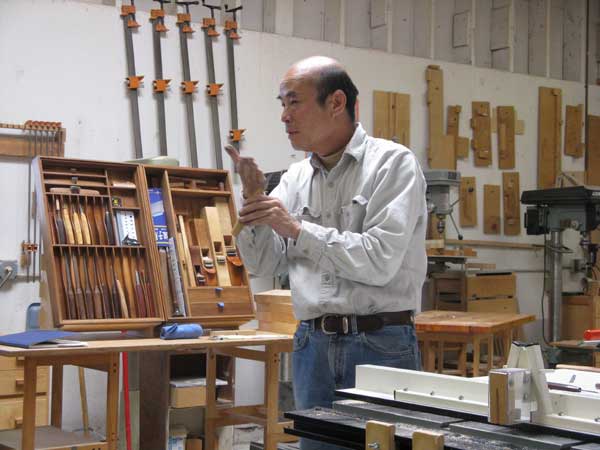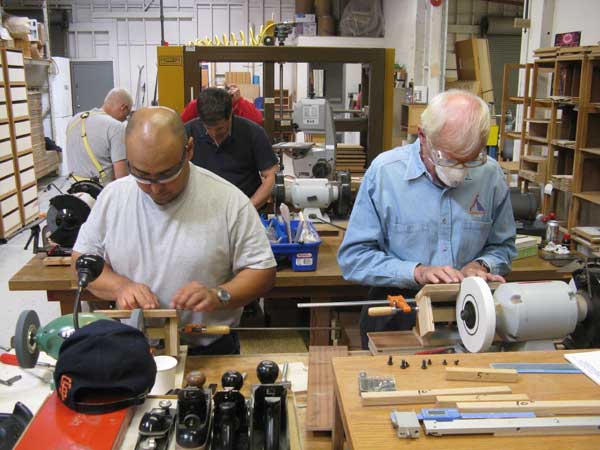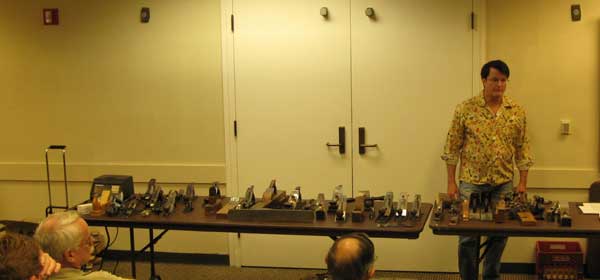
Last meeting
![]()
Frank Ramsey called the October meeting to order at 7:00pm.
A round of Announcements was next with Mark Rand describing the November Annual Box Contest and Jigs & Fixtures review.
George Bosworth has researched the issue of URLs for the BAWA website. We have been using the Geocities address, but it would be less expensive to have our own site. In addition, a URL with our name in it would be easier to remember than the present Geocities address. After some discussion, the members present voted unanimously to adopt "bayareawoodworkers.org" as the new URL for BAWA. All will be notified when the change is made.
Per Madsen described the Tool Making class presented by Yeung Chan and attended by several members of the club. Per was kind enough to host the seminar in his shop. Attendees were asked to bring bench grinders so that they could form and shape the 1/2 x ¼ inch Ron Hock tool steel into chisels and knives. Per showed photographs of the attendees busy at work on their grinders. Yeung had supplied each person with a fixture to use at the grinder. During the break we inspected the array of knives and chisels made by the BAWA students.



Stan Booker is selling raffle tickets for the Myrtle board. We still have a ways to go to break even, so there was no raffle this evening. Door prizes, however were abundant and included a $10 gift certificate from Woodcraft, sample bottles of glue and a tool bag.
Stan also described in more detail the work he and his wife are doing through the Asanti Network to support vocational schools in Tanzania. He continues to collect do-it-yourself and how-to books on carpentry and woodworking to distribute to these schools. The books subject must be hand tools. There are hardly any power tools since the electricity is not stable. Asanti is a recognized non-profit organization and therefore contributions are tax deductible.
Glenn Krueg has donated several good-sized pieces of Corian that are available for free.
Dan Goodman, the BAWA librarian announced that the club has several new DVDs that are available for rental, including topics of marquetry, box making and sharpening. He also mentioned that there were some items that have not been returned by members. He asked that they be returned.
A niece of Frank Sainsbury contacted Frank Ramsey to say that his tools are available for purchase. Frank Ramsey has the details so if you are interested, please contact him at frankramsay8@aol.com or 408 823-2382.
Frank then called on any guests to identify themselves. Lloyd Davies, Dave Harris, Allen Cary and William Pridgen were welcomed. Bill Pridgen also chose to join the club.
Next was Show & Tell:
Claude Godcharles is making a dining room table for a client and she has asked for all softened edges. The tabletop is made of 1 ½ inch Maple cut in an off-round shape. He was able to create the top edge with a large round-over bit. However, to create the 2 inch deep cove cut on the bottom, he found he could not control the heavy Maple top on the shaper. Therefore, with creativity and ingenuity, he modified a Sears Craftsman 7" circular saw to accept a molding head in place of the blade. Then he made a fixture to guide the saw around the edge of the tabletop. He covered the saw within the fixture for safety reasons. We marveled at his inventiveness and trembled at the thought of using the machine. Paramedics and an ambulance were called but Claude chose to not do a live demonstration.
Bruce Woods has made his daughter an amazing graduation present. He set out to make her a chessboard, but quickly discovered she really needed a box to house the board and pieces. He had found some prized Curly Maple boards undiscovered in a pile at a local lumberyard. He bought them for a song and began his project. The case is a large Curly Maple and Mahogany box with a curved lid. Opening the box one discovers a tray, divided into compartments to hold the individual chess pieces. The inside of the lid has two geometric shapes created with marquetry. The chessboard fits into a drawer like compartment in the bottom of the box. It is made of Acacia, Myrtle and Walnut.

The evening's main presentation was the Annual Hand Plane Seminar.
Once again the illustrious faculty of Neal White, Don Naples and Harold Patterson convened to demystify and share with us their collective knowledge of the mighty hand plane.
Neal White opened the seminar with a quote from one of his old Purdue college professors -- "hand planes have had their day and are going out of use." That was maybe 40 years ago? It was not why we had gathered here again. Somehow, every year this presentation is given, we all continue to learn something new. This year was not an exception.

When working at your bench, do you rest the hand plane on its sole or on its side when you put it down? Why? A vote was taken and the crowd was split, half the people rest the plane on its sole, half on its side. Neal argued for the sole -- you are less likely to damage the blade because it is not exposed to damage from contact with other tools. On the side of side placement there was the argument that a blade on the bench will lose its sharp edge.
Don Naples calmed the crowd and drew their attention to the array of planes displayed on the tables at the front of the room. Old wooden coffin planes can be found at garage sales for as little as $5. They may not be functioning planes, but the plane iron is usually high quality laminated steel. Buy it for the steel. If you are luck enough to find an old Stanley Bedrock plane, be prepared to recognize it. Bedrock planes are distinguished by the number "60" in front of the number designating the plane size; a 607, for instance is a size 7 Bedrock Trying Plane. Bedrock planes can have rounded or flat sides, with the flat being a later year model. Bedrock planes were last produced in 1943. The planes produced by Lie Nielsen are updated flat-sided Bedrock designs. Upgraded, thicker blades and chip breakers are available from Lie Nielsen, Ron Hock and Lee Valley Tools.
Other interesting Stanley planes include those with a corrugated sole the purpose of which was ostensibly to reduce friction. A myth we are told, but it does make it easier to flatten the sole because there is less metal to remove. Stanley also made a scraper model, the 12 or 12 ½. It had serrations in the blade designed to cut small grooves in the wood to facilitate veneer gluing.
Infill planes, produced in Great Britain, are the Cadillac of hand planes. There is more iron in the sole and body, and the plane iron is thicker making them heavier than the Stanley models. The advantages include no vibration, less tear out. Names to remember are Mathison, Norris and Spears. These planes frequently sell on Ebay for in excess of $1,000.
Other noteworthy planes include those produced by Terry Gordon in Australia and infill planes from St James. Marples made a bench plane with an adjustable throat. Krenov style wooden planes can be easily made by a woodworker and fitted with a Ron Hock blade.
So you have gone to the estate sale and found your treasure—a beautiful 406 Bedrock smoothing plane. Only it is dirty, rusty and the knob won't turn. Come on up Harold Patterson and tell us what to do. How do we refurbish this beauty?
First, soak it in mineral spirits to soften and remove the grime. Then wash it with soap and water. Remember to dry the plane after you wash it. Harold recommends putting it in your wife's oven at 250 degrees for one hour, but only when she has left the house on errands.
Once it is clean examine it for cracks at the throat and on the sides. If it is cracked you just bought spare parts. But assuming the body is intact, take it apart. Clean and flatten the frog or platform that the blade rests against. Flatten the bottom edge of the chip breaker that contacts the plane iron. Flatten the lever cap too. Reassemble the plane with the blade installed, but retracted. Flatten the base using aluminum oxide sand paper glued to a flat surface, like glass. Harold starts with 80 grit and works his way up 220. The critical areas to flatten on the sole are the front edge, the back edge and the area around the throat.
And what about the rust? You need electrolysis. Use your battery charger set at 2 amps. Put the plane in a tub, resting on non-conducting surface like wood or a sanding mat. Add a Baking Soda or a Washing Soda (Washing Soda is more effective) solution up to a level covering about half the plane. For more details on connecting the electrodes and the process itself, see Harold. Haroldp16@comcast.net or 650 349-7922.
Now you know how to restore a hand plane, but how do you recognize it? Stanley invented a numbering system that makes no sense. Neal spoke again to elucidate.
Block planes: the blade bevel goes up.
Bench planes: the blade bevel goes down.
Number/Name Length Comment
1. Bench 5 ½" Rare, not useful, collectible
2. Bench 7" Not as rare, collectible
3. Smoother 8" Most useful
4. Smoother 9" Useful too
5. Jack 14" Most common
6. Fore 18" Good to learn on
7. Try 22" Use for everything
8. Jointer 24" Beast of a tool
And just to confuse everyone, now bench planes are being offered with the bevel up, too.
Neal then described how he uses the #7 plane as a jointer plane. The blade has a slight camber so that once he has marked the high and low points along a board, he is able to guide the plane to cut a consistently flat surface. He also described how to make a shooting board to cut precise 90 and 45 degree angles.
The door prize drawing yielded prizes to two of the three presenters. Don Naples walked away with gift certificate. Neal won a prize and Harold called for a redrawing.
And as an addendum, Harold Patterson sends along the following website that has a fairly definitive article on hand planes: popularwoodworking.com/article/understanding_bench_planes.
Now get out there and cut it up.
John Blackmore & Mark Rand